Importance of Financial Management: Concept, Statements, Ratios, and Case Study Analysis
VerifiedAdded on 2023/06/14
|13
|2919
|270
AI Summary
This report covers the concept and importance of financial management, main financial statements, and the use of ratios in financial management. It also includes a case study analysis of a company's profitability, liquidity, and efficiency ratios. The report suggests improvements for the company's financial performance.
Contribute Materials
Your contribution can guide someone’s learning journey. Share your
documents today.

Importance of
Financial
Management
Financial
Management
Secure Best Marks with AI Grader
Need help grading? Try our AI Grader for instant feedback on your assignments.
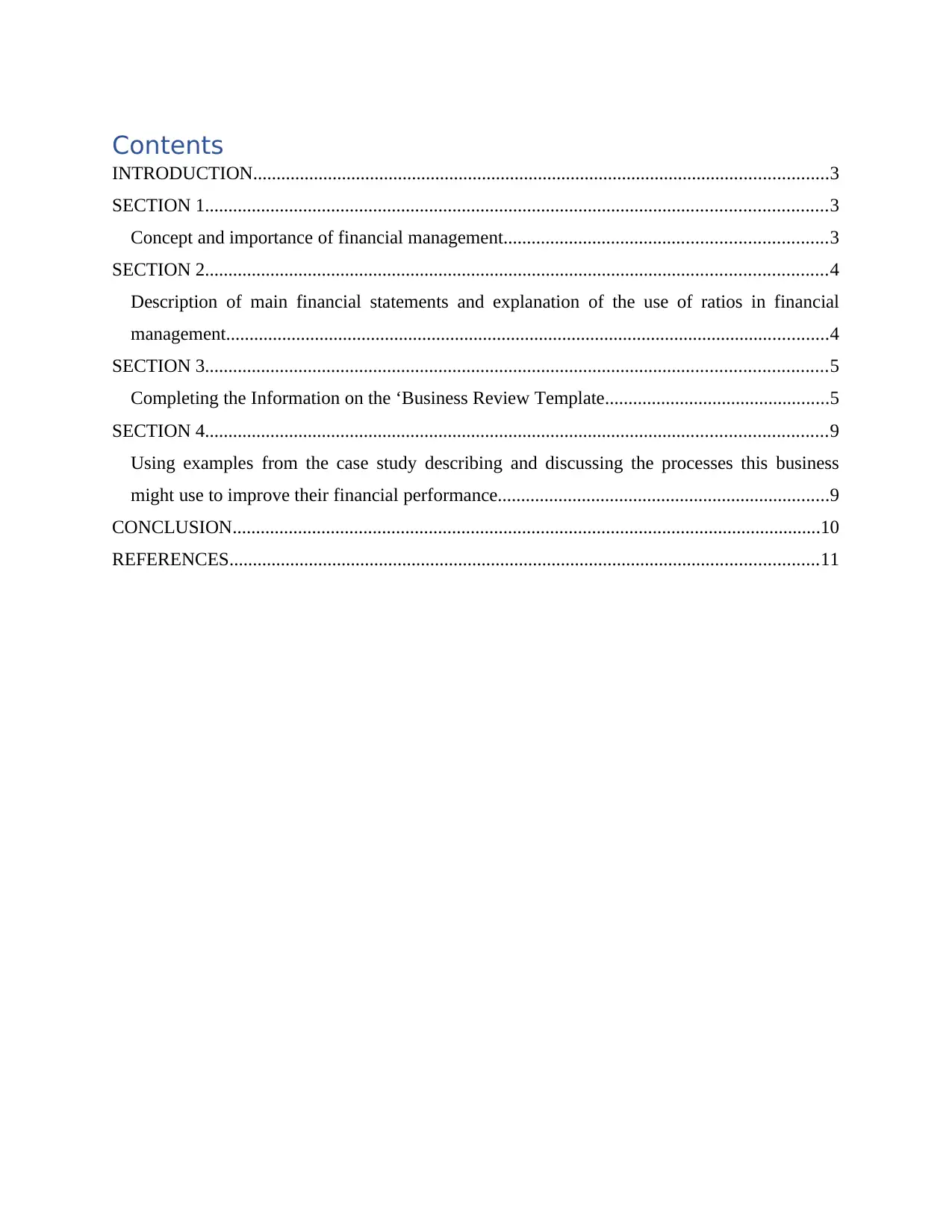
Contents
INTRODUCTION...........................................................................................................................3
SECTION 1.....................................................................................................................................3
Concept and importance of financial management.....................................................................3
SECTION 2.....................................................................................................................................4
Description of main financial statements and explanation of the use of ratios in financial
management.................................................................................................................................4
SECTION 3.....................................................................................................................................5
Completing the Information on the ‘Business Review Template................................................5
SECTION 4.....................................................................................................................................9
Using examples from the case study describing and discussing the processes this business
might use to improve their financial performance.......................................................................9
CONCLUSION..............................................................................................................................10
REFERENCES..............................................................................................................................11
INTRODUCTION...........................................................................................................................3
SECTION 1.....................................................................................................................................3
Concept and importance of financial management.....................................................................3
SECTION 2.....................................................................................................................................4
Description of main financial statements and explanation of the use of ratios in financial
management.................................................................................................................................4
SECTION 3.....................................................................................................................................5
Completing the Information on the ‘Business Review Template................................................5
SECTION 4.....................................................................................................................................9
Using examples from the case study describing and discussing the processes this business
might use to improve their financial performance.......................................................................9
CONCLUSION..............................................................................................................................10
REFERENCES..............................................................................................................................11
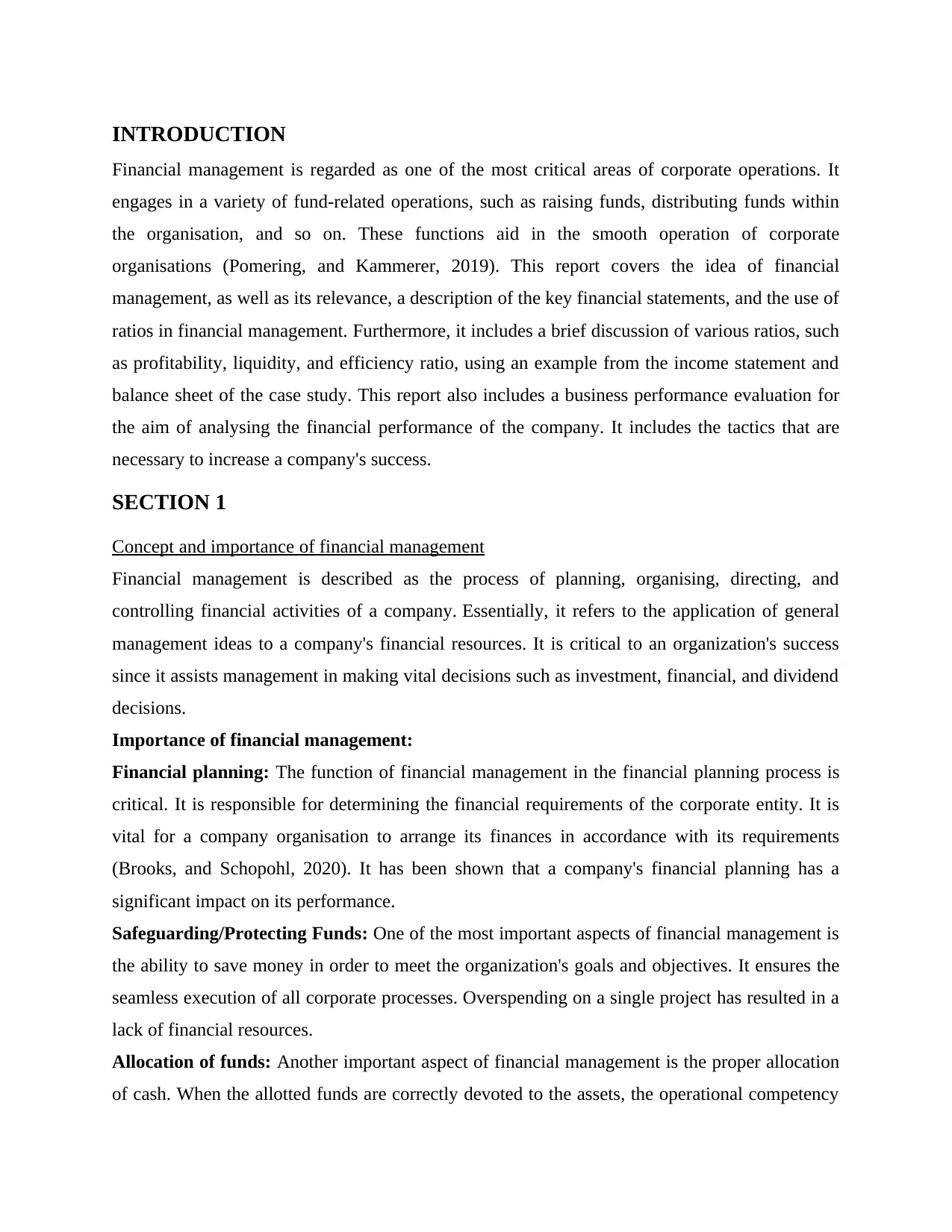
INTRODUCTION
Financial management is regarded as one of the most critical areas of corporate operations. It
engages in a variety of fund-related operations, such as raising funds, distributing funds within
the organisation, and so on. These functions aid in the smooth operation of corporate
organisations (Pomering, and Kammerer, 2019). This report covers the idea of financial
management, as well as its relevance, a description of the key financial statements, and the use of
ratios in financial management. Furthermore, it includes a brief discussion of various ratios, such
as profitability, liquidity, and efficiency ratio, using an example from the income statement and
balance sheet of the case study. This report also includes a business performance evaluation for
the aim of analysing the financial performance of the company. It includes the tactics that are
necessary to increase a company's success.
SECTION 1
Concept and importance of financial management
Financial management is described as the process of planning, organising, directing, and
controlling financial activities of a company. Essentially, it refers to the application of general
management ideas to a company's financial resources. It is critical to an organization's success
since it assists management in making vital decisions such as investment, financial, and dividend
decisions.
Importance of financial management:
Financial planning: The function of financial management in the financial planning process is
critical. It is responsible for determining the financial requirements of the corporate entity. It is
vital for a company organisation to arrange its finances in accordance with its requirements
(Brooks, and Schopohl, 2020). It has been shown that a company's financial planning has a
significant impact on its performance.
Safeguarding/Protecting Funds: One of the most important aspects of financial management is
the ability to save money in order to meet the organization's goals and objectives. It ensures the
seamless execution of all corporate processes. Overspending on a single project has resulted in a
lack of financial resources.
Allocation of funds: Another important aspect of financial management is the proper allocation
of cash. When the allotted funds are correctly devoted to the assets, the operational competency
Financial management is regarded as one of the most critical areas of corporate operations. It
engages in a variety of fund-related operations, such as raising funds, distributing funds within
the organisation, and so on. These functions aid in the smooth operation of corporate
organisations (Pomering, and Kammerer, 2019). This report covers the idea of financial
management, as well as its relevance, a description of the key financial statements, and the use of
ratios in financial management. Furthermore, it includes a brief discussion of various ratios, such
as profitability, liquidity, and efficiency ratio, using an example from the income statement and
balance sheet of the case study. This report also includes a business performance evaluation for
the aim of analysing the financial performance of the company. It includes the tactics that are
necessary to increase a company's success.
SECTION 1
Concept and importance of financial management
Financial management is described as the process of planning, organising, directing, and
controlling financial activities of a company. Essentially, it refers to the application of general
management ideas to a company's financial resources. It is critical to an organization's success
since it assists management in making vital decisions such as investment, financial, and dividend
decisions.
Importance of financial management:
Financial planning: The function of financial management in the financial planning process is
critical. It is responsible for determining the financial requirements of the corporate entity. It is
vital for a company organisation to arrange its finances in accordance with its requirements
(Brooks, and Schopohl, 2020). It has been shown that a company's financial planning has a
significant impact on its performance.
Safeguarding/Protecting Funds: One of the most important aspects of financial management is
the ability to save money in order to meet the organization's goals and objectives. It ensures the
seamless execution of all corporate processes. Overspending on a single project has resulted in a
lack of financial resources.
Allocation of funds: Another important aspect of financial management is the proper allocation
of cash. When the allotted funds are correctly devoted to the assets, the operational competency
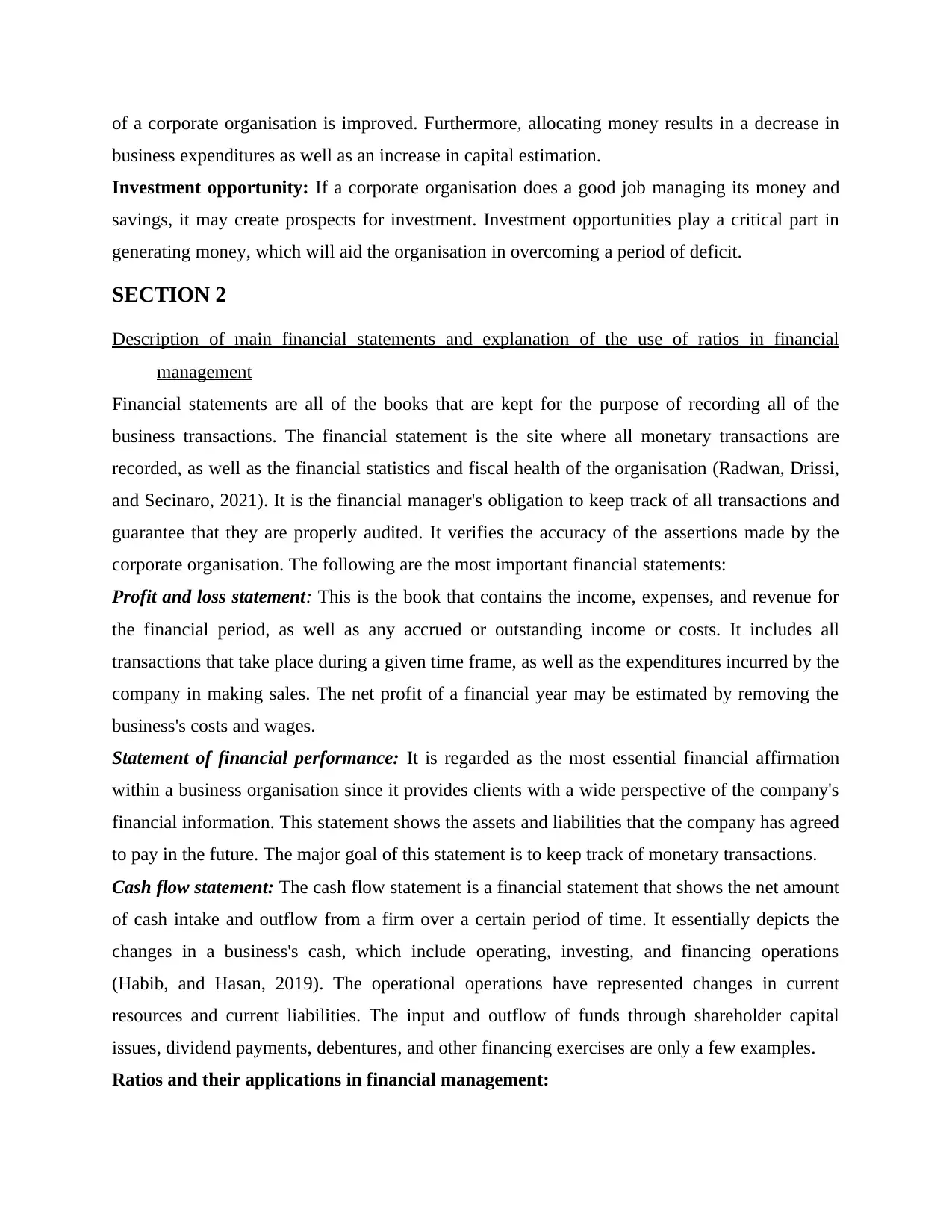
of a corporate organisation is improved. Furthermore, allocating money results in a decrease in
business expenditures as well as an increase in capital estimation.
Investment opportunity: If a corporate organisation does a good job managing its money and
savings, it may create prospects for investment. Investment opportunities play a critical part in
generating money, which will aid the organisation in overcoming a period of deficit.
SECTION 2
Description of main financial statements and explanation of the use of ratios in financial
management
Financial statements are all of the books that are kept for the purpose of recording all of the
business transactions. The financial statement is the site where all monetary transactions are
recorded, as well as the financial statistics and fiscal health of the organisation (Radwan, Drissi,
and Secinaro, 2021). It is the financial manager's obligation to keep track of all transactions and
guarantee that they are properly audited. It verifies the accuracy of the assertions made by the
corporate organisation. The following are the most important financial statements:
Profit and loss statement: This is the book that contains the income, expenses, and revenue for
the financial period, as well as any accrued or outstanding income or costs. It includes all
transactions that take place during a given time frame, as well as the expenditures incurred by the
company in making sales. The net profit of a financial year may be estimated by removing the
business's costs and wages.
Statement of financial performance: It is regarded as the most essential financial affirmation
within a business organisation since it provides clients with a wide perspective of the company's
financial information. This statement shows the assets and liabilities that the company has agreed
to pay in the future. The major goal of this statement is to keep track of monetary transactions.
Cash flow statement: The cash flow statement is a financial statement that shows the net amount
of cash intake and outflow from a firm over a certain period of time. It essentially depicts the
changes in a business's cash, which include operating, investing, and financing operations
(Habib, and Hasan, 2019). The operational operations have represented changes in current
resources and current liabilities. The input and outflow of funds through shareholder capital
issues, dividend payments, debentures, and other financing exercises are only a few examples.
Ratios and their applications in financial management:
business expenditures as well as an increase in capital estimation.
Investment opportunity: If a corporate organisation does a good job managing its money and
savings, it may create prospects for investment. Investment opportunities play a critical part in
generating money, which will aid the organisation in overcoming a period of deficit.
SECTION 2
Description of main financial statements and explanation of the use of ratios in financial
management
Financial statements are all of the books that are kept for the purpose of recording all of the
business transactions. The financial statement is the site where all monetary transactions are
recorded, as well as the financial statistics and fiscal health of the organisation (Radwan, Drissi,
and Secinaro, 2021). It is the financial manager's obligation to keep track of all transactions and
guarantee that they are properly audited. It verifies the accuracy of the assertions made by the
corporate organisation. The following are the most important financial statements:
Profit and loss statement: This is the book that contains the income, expenses, and revenue for
the financial period, as well as any accrued or outstanding income or costs. It includes all
transactions that take place during a given time frame, as well as the expenditures incurred by the
company in making sales. The net profit of a financial year may be estimated by removing the
business's costs and wages.
Statement of financial performance: It is regarded as the most essential financial affirmation
within a business organisation since it provides clients with a wide perspective of the company's
financial information. This statement shows the assets and liabilities that the company has agreed
to pay in the future. The major goal of this statement is to keep track of monetary transactions.
Cash flow statement: The cash flow statement is a financial statement that shows the net amount
of cash intake and outflow from a firm over a certain period of time. It essentially depicts the
changes in a business's cash, which include operating, investing, and financing operations
(Habib, and Hasan, 2019). The operational operations have represented changes in current
resources and current liabilities. The input and outflow of funds through shareholder capital
issues, dividend payments, debentures, and other financing exercises are only a few examples.
Ratios and their applications in financial management:
Secure Best Marks with AI Grader
Need help grading? Try our AI Grader for instant feedback on your assignments.
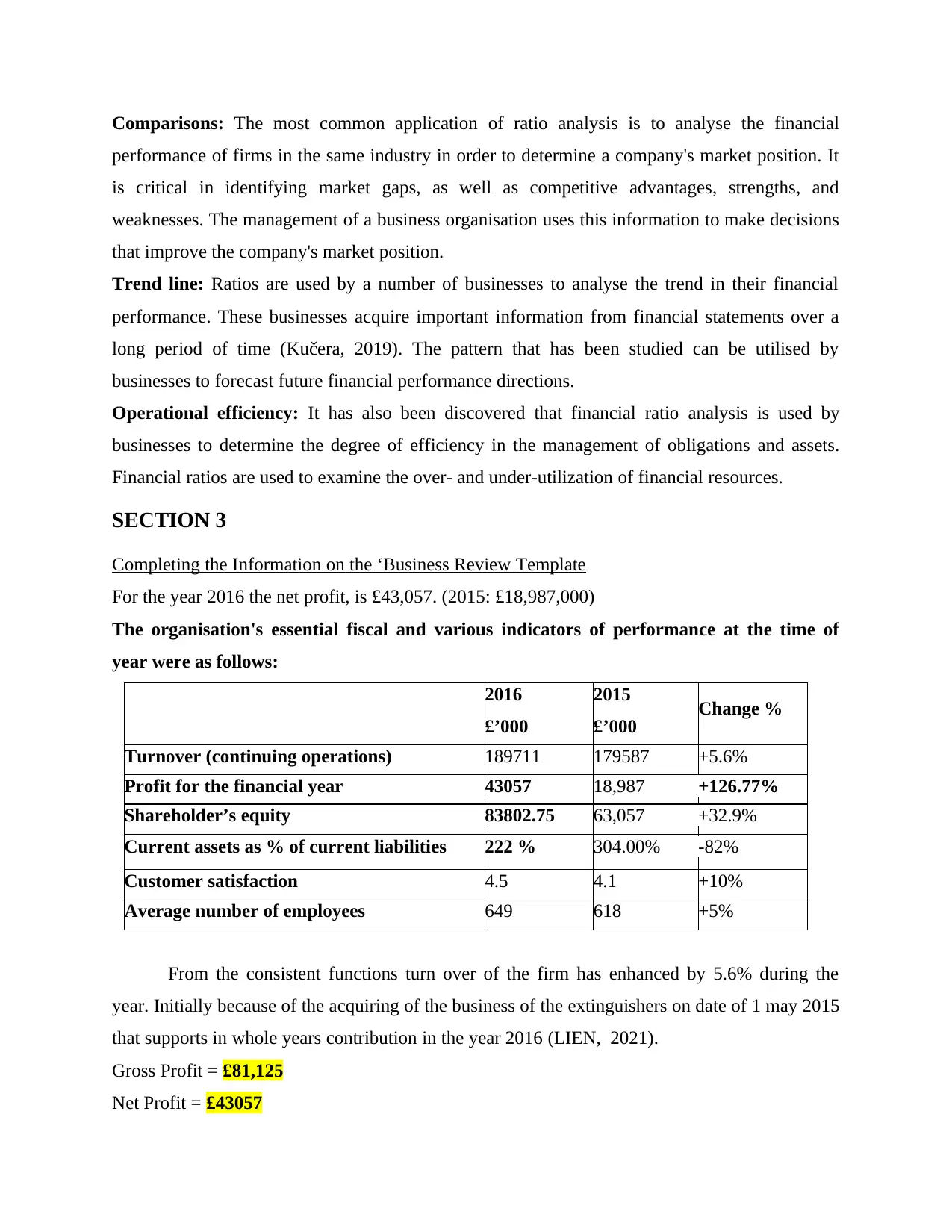
Comparisons: The most common application of ratio analysis is to analyse the financial
performance of firms in the same industry in order to determine a company's market position. It
is critical in identifying market gaps, as well as competitive advantages, strengths, and
weaknesses. The management of a business organisation uses this information to make decisions
that improve the company's market position.
Trend line: Ratios are used by a number of businesses to analyse the trend in their financial
performance. These businesses acquire important information from financial statements over a
long period of time (Kučera, 2019). The pattern that has been studied can be utilised by
businesses to forecast future financial performance directions.
Operational efficiency: It has also been discovered that financial ratio analysis is used by
businesses to determine the degree of efficiency in the management of obligations and assets.
Financial ratios are used to examine the over- and under-utilization of financial resources.
SECTION 3
Completing the Information on the ‘Business Review Template
For the year 2016 the net profit, is £43,057. (2015: £18,987,000)
The organisation's essential fiscal and various indicators of performance at the time of
year were as follows:
2016
£’000
2015
£’000 Change %
Turnover (continuing operations) 189711 179587 +5.6%
Profit for the financial year 43057 18,987 +126.77%
Shareholder’s equity 83802.75 63,057 +32.9%
Current assets as % of current liabilities 222 % 304.00% -82%
Customer satisfaction 4.5 4.1 +10%
Average number of employees 649 618 +5%
From the consistent functions turn over of the firm has enhanced by 5.6% during the
year. Initially because of the acquiring of the business of the extinguishers on date of 1 may 2015
that supports in whole years contribution in the year 2016 (LIEN, 2021).
Gross Profit = £81,125
Net Profit = £43057
performance of firms in the same industry in order to determine a company's market position. It
is critical in identifying market gaps, as well as competitive advantages, strengths, and
weaknesses. The management of a business organisation uses this information to make decisions
that improve the company's market position.
Trend line: Ratios are used by a number of businesses to analyse the trend in their financial
performance. These businesses acquire important information from financial statements over a
long period of time (Kučera, 2019). The pattern that has been studied can be utilised by
businesses to forecast future financial performance directions.
Operational efficiency: It has also been discovered that financial ratio analysis is used by
businesses to determine the degree of efficiency in the management of obligations and assets.
Financial ratios are used to examine the over- and under-utilization of financial resources.
SECTION 3
Completing the Information on the ‘Business Review Template
For the year 2016 the net profit, is £43,057. (2015: £18,987,000)
The organisation's essential fiscal and various indicators of performance at the time of
year were as follows:
2016
£’000
2015
£’000 Change %
Turnover (continuing operations) 189711 179587 +5.6%
Profit for the financial year 43057 18,987 +126.77%
Shareholder’s equity 83802.75 63,057 +32.9%
Current assets as % of current liabilities 222 % 304.00% -82%
Customer satisfaction 4.5 4.1 +10%
Average number of employees 649 618 +5%
From the consistent functions turn over of the firm has enhanced by 5.6% during the
year. Initially because of the acquiring of the business of the extinguishers on date of 1 may 2015
that supports in whole years contribution in the year 2016 (LIEN, 2021).
Gross Profit = £81,125
Net Profit = £43057
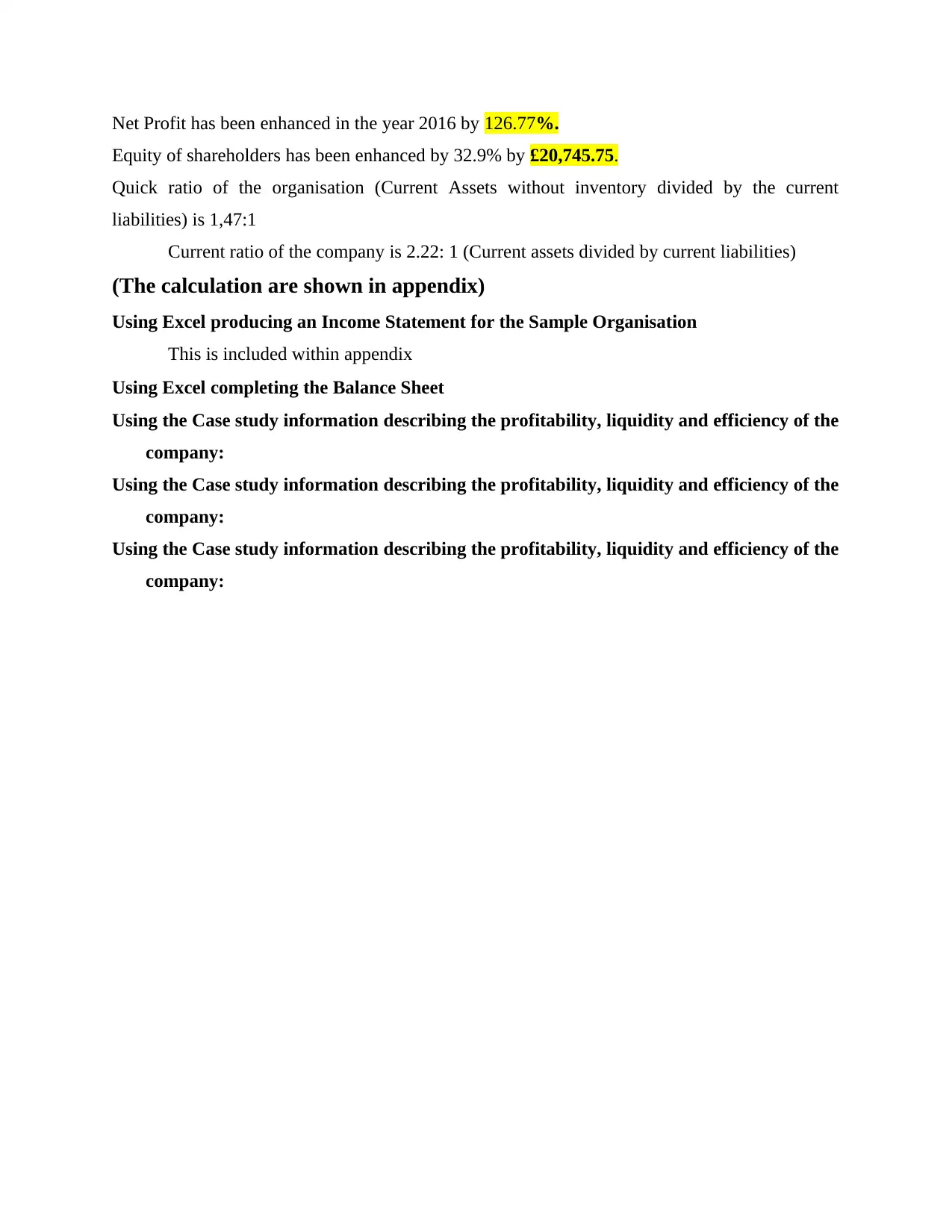
Net Profit has been enhanced in the year 2016 by 126.77%.
Equity of shareholders has been enhanced by 32.9% by £20,745.75.
Quick ratio of the organisation (Current Assets without inventory divided by the current
liabilities) is 1,47:1
Current ratio of the company is 2.22: 1 (Current assets divided by current liabilities)
(The calculation are shown in appendix)
Using Excel producing an Income Statement for the Sample Organisation
This is included within appendix
Using Excel completing the Balance Sheet
Using the Case study information describing the profitability, liquidity and efficiency of the
company:
Using the Case study information describing the profitability, liquidity and efficiency of the
company:
Using the Case study information describing the profitability, liquidity and efficiency of the
company:
Equity of shareholders has been enhanced by 32.9% by £20,745.75.
Quick ratio of the organisation (Current Assets without inventory divided by the current
liabilities) is 1,47:1
Current ratio of the company is 2.22: 1 (Current assets divided by current liabilities)
(The calculation are shown in appendix)
Using Excel producing an Income Statement for the Sample Organisation
This is included within appendix
Using Excel completing the Balance Sheet
Using the Case study information describing the profitability, liquidity and efficiency of the
company:
Using the Case study information describing the profitability, liquidity and efficiency of the
company:
Using the Case study information describing the profitability, liquidity and efficiency of the
company:
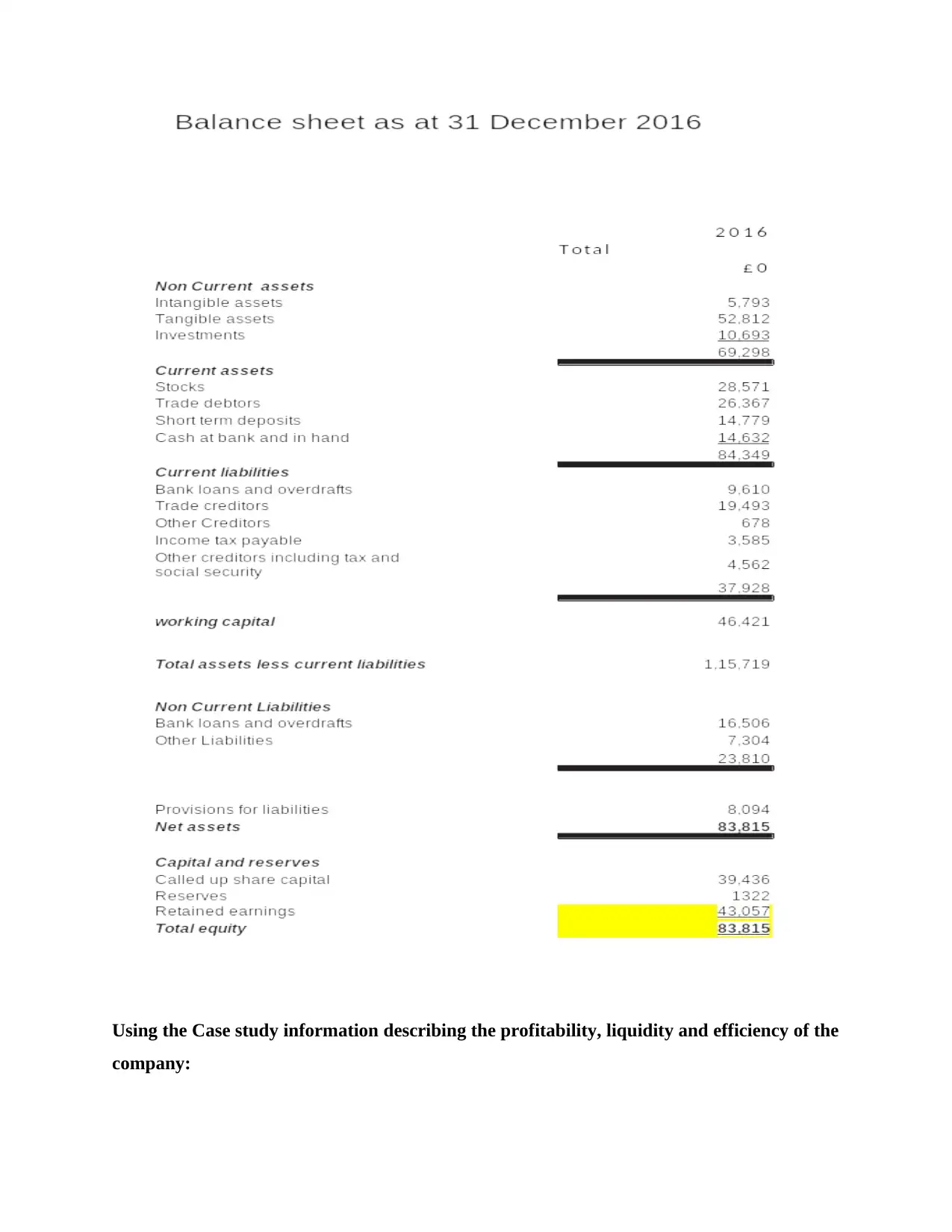
Using the Case study information describing the profitability, liquidity and efficiency of the
company:
company:
Paraphrase This Document
Need a fresh take? Get an instant paraphrase of this document with our AI Paraphraser
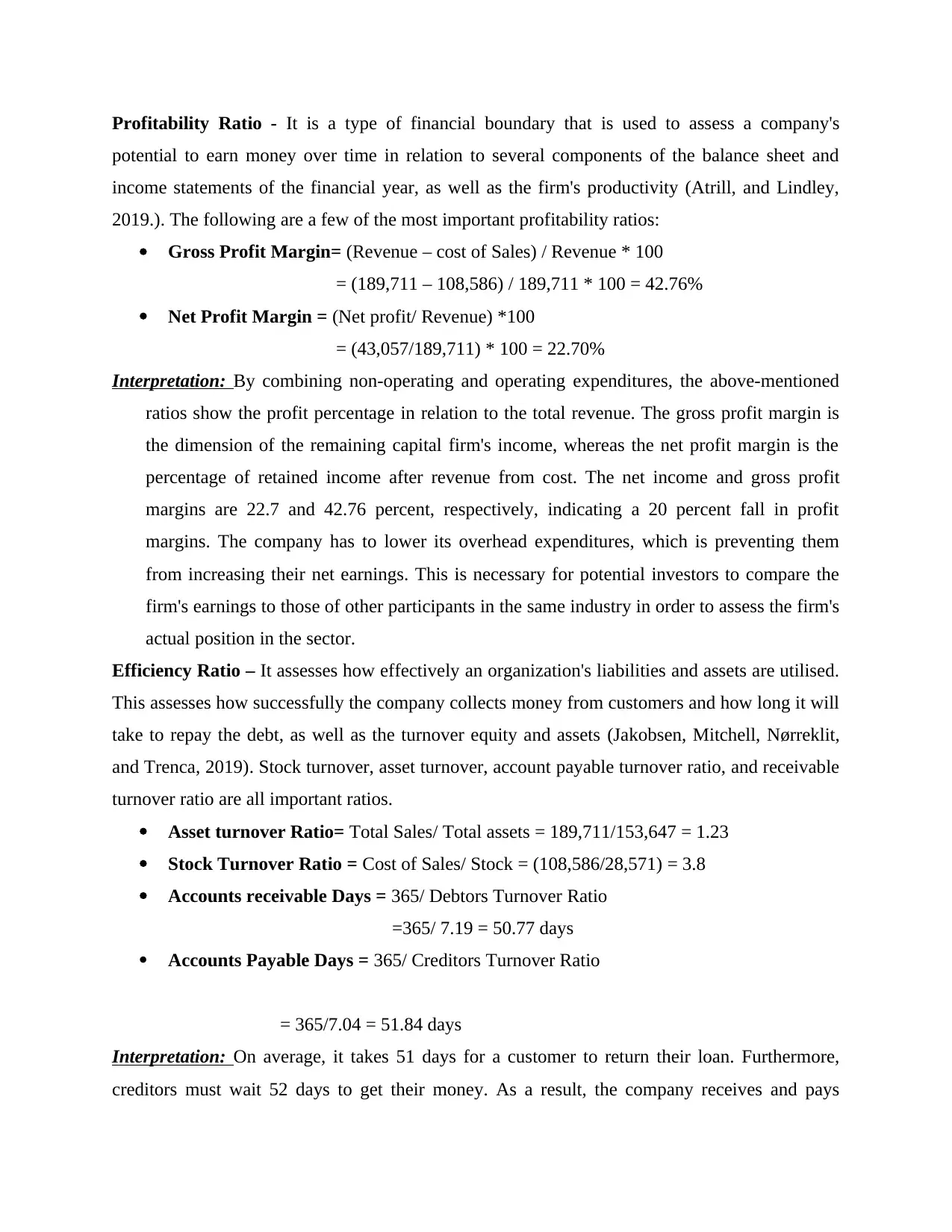
Profitability Ratio - It is a type of financial boundary that is used to assess a company's
potential to earn money over time in relation to several components of the balance sheet and
income statements of the financial year, as well as the firm's productivity (Atrill, and Lindley,
2019.). The following are a few of the most important profitability ratios:
Gross Profit Margin= (Revenue – cost of Sales) / Revenue * 100
= (189,711 – 108,586) / 189,711 * 100 = 42.76%
Net Profit Margin = (Net profit/ Revenue) *100
= (43,057/189,711) * 100 = 22.70%
Interpretation: By combining non-operating and operating expenditures, the above-mentioned
ratios show the profit percentage in relation to the total revenue. The gross profit margin is
the dimension of the remaining capital firm's income, whereas the net profit margin is the
percentage of retained income after revenue from cost. The net income and gross profit
margins are 22.7 and 42.76 percent, respectively, indicating a 20 percent fall in profit
margins. The company has to lower its overhead expenditures, which is preventing them
from increasing their net earnings. This is necessary for potential investors to compare the
firm's earnings to those of other participants in the same industry in order to assess the firm's
actual position in the sector.
Efficiency Ratio – It assesses how effectively an organization's liabilities and assets are utilised.
This assesses how successfully the company collects money from customers and how long it will
take to repay the debt, as well as the turnover equity and assets (Jakobsen, Mitchell, Nørreklit,
and Trenca, 2019). Stock turnover, asset turnover, account payable turnover ratio, and receivable
turnover ratio are all important ratios.
Asset turnover Ratio= Total Sales/ Total assets = 189,711/153,647 = 1.23
Stock Turnover Ratio = Cost of Sales/ Stock = (108,586/28,571) = 3.8
Accounts receivable Days = 365/ Debtors Turnover Ratio
=365/ 7.19 = 50.77 days
Accounts Payable Days = 365/ Creditors Turnover Ratio
= 365/7.04 = 51.84 days
Interpretation: On average, it takes 51 days for a customer to return their loan. Furthermore,
creditors must wait 52 days to get their money. As a result, the company receives and pays
potential to earn money over time in relation to several components of the balance sheet and
income statements of the financial year, as well as the firm's productivity (Atrill, and Lindley,
2019.). The following are a few of the most important profitability ratios:
Gross Profit Margin= (Revenue – cost of Sales) / Revenue * 100
= (189,711 – 108,586) / 189,711 * 100 = 42.76%
Net Profit Margin = (Net profit/ Revenue) *100
= (43,057/189,711) * 100 = 22.70%
Interpretation: By combining non-operating and operating expenditures, the above-mentioned
ratios show the profit percentage in relation to the total revenue. The gross profit margin is
the dimension of the remaining capital firm's income, whereas the net profit margin is the
percentage of retained income after revenue from cost. The net income and gross profit
margins are 22.7 and 42.76 percent, respectively, indicating a 20 percent fall in profit
margins. The company has to lower its overhead expenditures, which is preventing them
from increasing their net earnings. This is necessary for potential investors to compare the
firm's earnings to those of other participants in the same industry in order to assess the firm's
actual position in the sector.
Efficiency Ratio – It assesses how effectively an organization's liabilities and assets are utilised.
This assesses how successfully the company collects money from customers and how long it will
take to repay the debt, as well as the turnover equity and assets (Jakobsen, Mitchell, Nørreklit,
and Trenca, 2019). Stock turnover, asset turnover, account payable turnover ratio, and receivable
turnover ratio are all important ratios.
Asset turnover Ratio= Total Sales/ Total assets = 189,711/153,647 = 1.23
Stock Turnover Ratio = Cost of Sales/ Stock = (108,586/28,571) = 3.8
Accounts receivable Days = 365/ Debtors Turnover Ratio
=365/ 7.19 = 50.77 days
Accounts Payable Days = 365/ Creditors Turnover Ratio
= 365/7.04 = 51.84 days
Interpretation: On average, it takes 51 days for a customer to return their loan. Furthermore,
creditors must wait 52 days to get their money. As a result, the company receives and pays
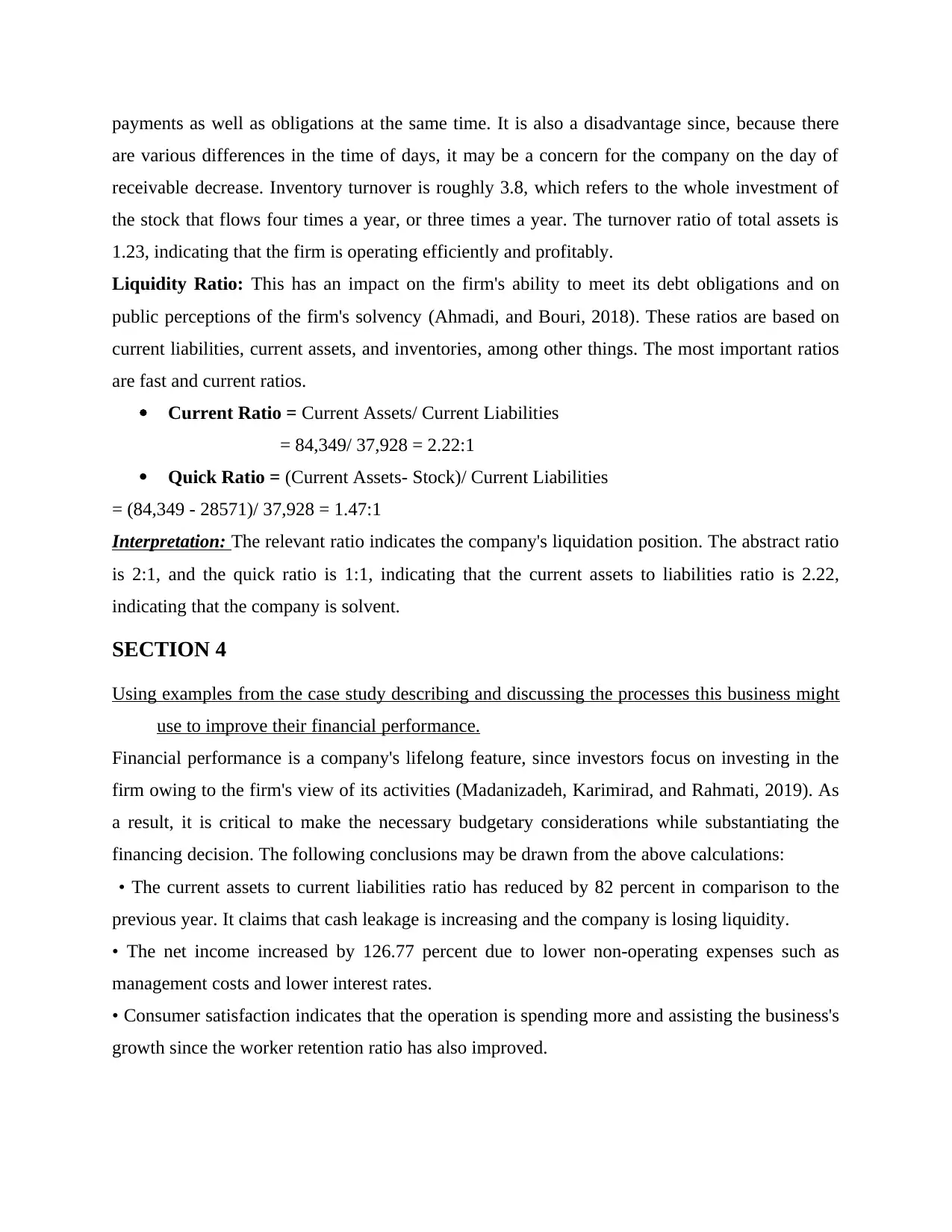
payments as well as obligations at the same time. It is also a disadvantage since, because there
are various differences in the time of days, it may be a concern for the company on the day of
receivable decrease. Inventory turnover is roughly 3.8, which refers to the whole investment of
the stock that flows four times a year, or three times a year. The turnover ratio of total assets is
1.23, indicating that the firm is operating efficiently and profitably.
Liquidity Ratio: This has an impact on the firm's ability to meet its debt obligations and on
public perceptions of the firm's solvency (Ahmadi, and Bouri, 2018). These ratios are based on
current liabilities, current assets, and inventories, among other things. The most important ratios
are fast and current ratios.
Current Ratio = Current Assets/ Current Liabilities
= 84,349/ 37,928 = 2.22:1
Quick Ratio = (Current Assets- Stock)/ Current Liabilities
= (84,349 - 28571)/ 37,928 = 1.47:1
Interpretation: The relevant ratio indicates the company's liquidation position. The abstract ratio
is 2:1, and the quick ratio is 1:1, indicating that the current assets to liabilities ratio is 2.22,
indicating that the company is solvent.
SECTION 4
Using examples from the case study describing and discussing the processes this business might
use to improve their financial performance.
Financial performance is a company's lifelong feature, since investors focus on investing in the
firm owing to the firm's view of its activities (Madanizadeh, Karimirad, and Rahmati, 2019). As
a result, it is critical to make the necessary budgetary considerations while substantiating the
financing decision. The following conclusions may be drawn from the above calculations:
• The current assets to current liabilities ratio has reduced by 82 percent in comparison to the
previous year. It claims that cash leakage is increasing and the company is losing liquidity.
• The net income increased by 126.77 percent due to lower non-operating expenses such as
management costs and lower interest rates.
• Consumer satisfaction indicates that the operation is spending more and assisting the business's
growth since the worker retention ratio has also improved.
are various differences in the time of days, it may be a concern for the company on the day of
receivable decrease. Inventory turnover is roughly 3.8, which refers to the whole investment of
the stock that flows four times a year, or three times a year. The turnover ratio of total assets is
1.23, indicating that the firm is operating efficiently and profitably.
Liquidity Ratio: This has an impact on the firm's ability to meet its debt obligations and on
public perceptions of the firm's solvency (Ahmadi, and Bouri, 2018). These ratios are based on
current liabilities, current assets, and inventories, among other things. The most important ratios
are fast and current ratios.
Current Ratio = Current Assets/ Current Liabilities
= 84,349/ 37,928 = 2.22:1
Quick Ratio = (Current Assets- Stock)/ Current Liabilities
= (84,349 - 28571)/ 37,928 = 1.47:1
Interpretation: The relevant ratio indicates the company's liquidation position. The abstract ratio
is 2:1, and the quick ratio is 1:1, indicating that the current assets to liabilities ratio is 2.22,
indicating that the company is solvent.
SECTION 4
Using examples from the case study describing and discussing the processes this business might
use to improve their financial performance.
Financial performance is a company's lifelong feature, since investors focus on investing in the
firm owing to the firm's view of its activities (Madanizadeh, Karimirad, and Rahmati, 2019). As
a result, it is critical to make the necessary budgetary considerations while substantiating the
financing decision. The following conclusions may be drawn from the above calculations:
• The current assets to current liabilities ratio has reduced by 82 percent in comparison to the
previous year. It claims that cash leakage is increasing and the company is losing liquidity.
• The net income increased by 126.77 percent due to lower non-operating expenses such as
management costs and lower interest rates.
• Consumer satisfaction indicates that the operation is spending more and assisting the business's
growth since the worker retention ratio has also improved.
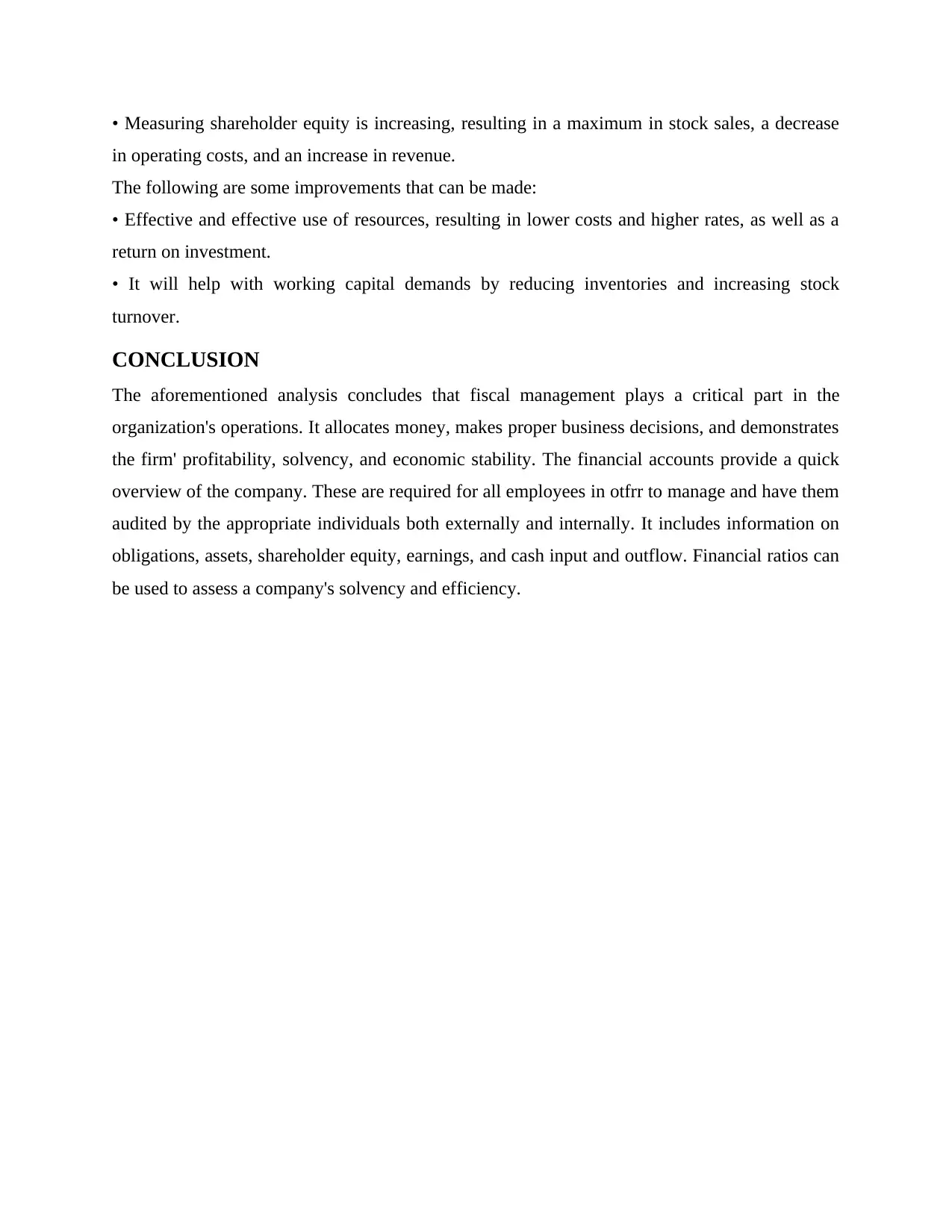
• Measuring shareholder equity is increasing, resulting in a maximum in stock sales, a decrease
in operating costs, and an increase in revenue.
The following are some improvements that can be made:
• Effective and effective use of resources, resulting in lower costs and higher rates, as well as a
return on investment.
• It will help with working capital demands by reducing inventories and increasing stock
turnover.
CONCLUSION
The aforementioned analysis concludes that fiscal management plays a critical part in the
organization's operations. It allocates money, makes proper business decisions, and demonstrates
the firm' profitability, solvency, and economic stability. The financial accounts provide a quick
overview of the company. These are required for all employees in otfrr to manage and have them
audited by the appropriate individuals both externally and internally. It includes information on
obligations, assets, shareholder equity, earnings, and cash input and outflow. Financial ratios can
be used to assess a company's solvency and efficiency.
in operating costs, and an increase in revenue.
The following are some improvements that can be made:
• Effective and effective use of resources, resulting in lower costs and higher rates, as well as a
return on investment.
• It will help with working capital demands by reducing inventories and increasing stock
turnover.
CONCLUSION
The aforementioned analysis concludes that fiscal management plays a critical part in the
organization's operations. It allocates money, makes proper business decisions, and demonstrates
the firm' profitability, solvency, and economic stability. The financial accounts provide a quick
overview of the company. These are required for all employees in otfrr to manage and have them
audited by the appropriate individuals both externally and internally. It includes information on
obligations, assets, shareholder equity, earnings, and cash input and outflow. Financial ratios can
be used to assess a company's solvency and efficiency.
Secure Best Marks with AI Grader
Need help grading? Try our AI Grader for instant feedback on your assignments.
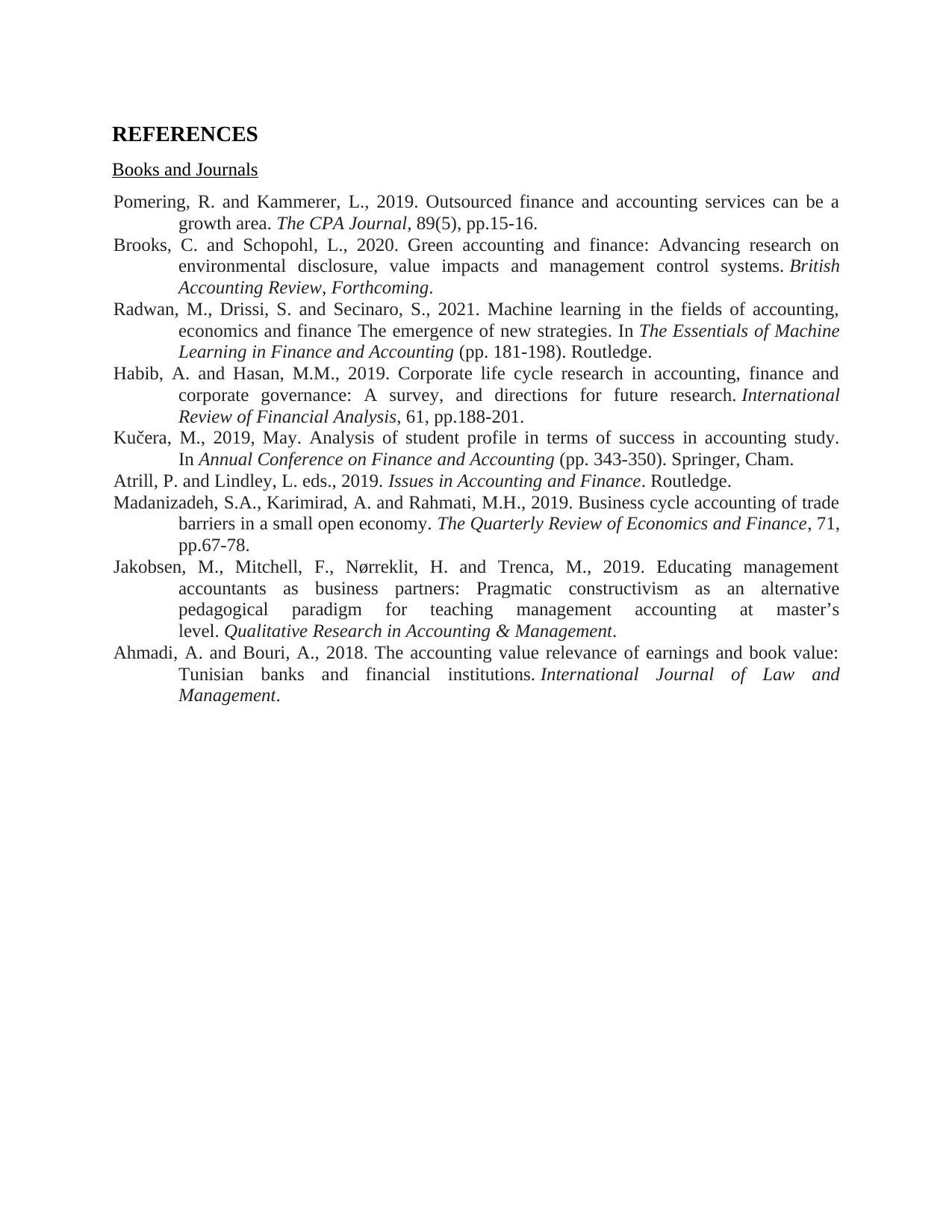
REFERENCES
Books and Journals
Pomering, R. and Kammerer, L., 2019. Outsourced finance and accounting services can be a
growth area. The CPA Journal, 89(5), pp.15-16.
Brooks, C. and Schopohl, L., 2020. Green accounting and finance: Advancing research on
environmental disclosure, value impacts and management control systems. British
Accounting Review, Forthcoming.
Radwan, M., Drissi, S. and Secinaro, S., 2021. Machine learning in the fields of accounting,
economics and finance The emergence of new strategies. In The Essentials of Machine
Learning in Finance and Accounting (pp. 181-198). Routledge.
Habib, A. and Hasan, M.M., 2019. Corporate life cycle research in accounting, finance and
corporate governance: A survey, and directions for future research. International
Review of Financial Analysis, 61, pp.188-201.
Kučera, M., 2019, May. Analysis of student profile in terms of success in accounting study.
In Annual Conference on Finance and Accounting (pp. 343-350). Springer, Cham.
Atrill, P. and Lindley, L. eds., 2019. Issues in Accounting and Finance. Routledge.
Madanizadeh, S.A., Karimirad, A. and Rahmati, M.H., 2019. Business cycle accounting of trade
barriers in a small open economy. The Quarterly Review of Economics and Finance, 71,
pp.67-78.
Jakobsen, M., Mitchell, F., Nørreklit, H. and Trenca, M., 2019. Educating management
accountants as business partners: Pragmatic constructivism as an alternative
pedagogical paradigm for teaching management accounting at master’s
level. Qualitative Research in Accounting & Management.
Ahmadi, A. and Bouri, A., 2018. The accounting value relevance of earnings and book value:
Tunisian banks and financial institutions. International Journal of Law and
Management.
Books and Journals
Pomering, R. and Kammerer, L., 2019. Outsourced finance and accounting services can be a
growth area. The CPA Journal, 89(5), pp.15-16.
Brooks, C. and Schopohl, L., 2020. Green accounting and finance: Advancing research on
environmental disclosure, value impacts and management control systems. British
Accounting Review, Forthcoming.
Radwan, M., Drissi, S. and Secinaro, S., 2021. Machine learning in the fields of accounting,
economics and finance The emergence of new strategies. In The Essentials of Machine
Learning in Finance and Accounting (pp. 181-198). Routledge.
Habib, A. and Hasan, M.M., 2019. Corporate life cycle research in accounting, finance and
corporate governance: A survey, and directions for future research. International
Review of Financial Analysis, 61, pp.188-201.
Kučera, M., 2019, May. Analysis of student profile in terms of success in accounting study.
In Annual Conference on Finance and Accounting (pp. 343-350). Springer, Cham.
Atrill, P. and Lindley, L. eds., 2019. Issues in Accounting and Finance. Routledge.
Madanizadeh, S.A., Karimirad, A. and Rahmati, M.H., 2019. Business cycle accounting of trade
barriers in a small open economy. The Quarterly Review of Economics and Finance, 71,
pp.67-78.
Jakobsen, M., Mitchell, F., Nørreklit, H. and Trenca, M., 2019. Educating management
accountants as business partners: Pragmatic constructivism as an alternative
pedagogical paradigm for teaching management accounting at master’s
level. Qualitative Research in Accounting & Management.
Ahmadi, A. and Bouri, A., 2018. The accounting value relevance of earnings and book value:
Tunisian banks and financial institutions. International Journal of Law and
Management.
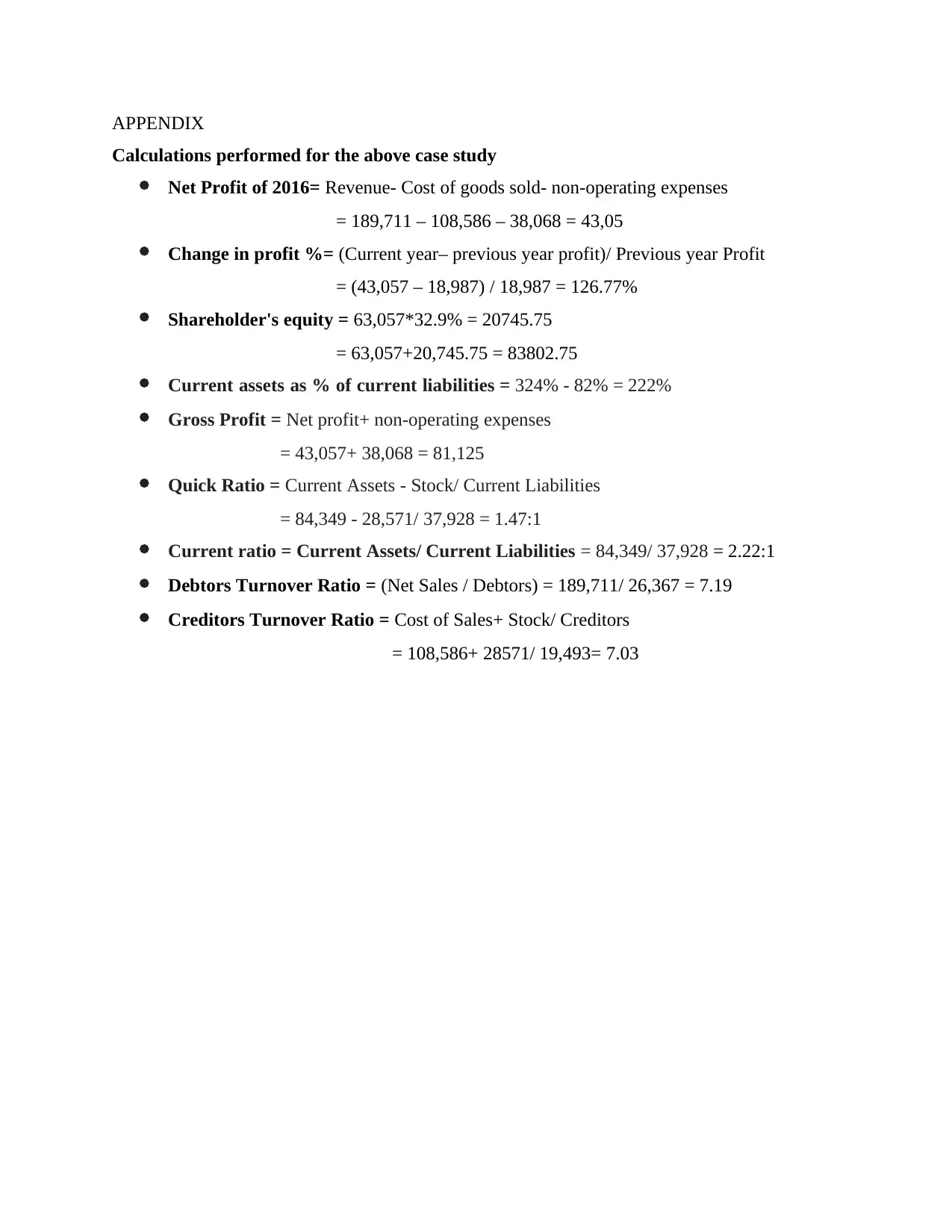
APPENDIX
Calculations performed for the above case study
Net Profit of 2016= Revenue- Cost of goods sold- non-operating expenses
= 189,711 – 108,586 – 38,068 = 43,05
Change in profit %= (Current year– previous year profit)/ Previous year Profit
= (43,057 – 18,987) / 18,987 = 126.77%
Shareholder's equity = 63,057*32.9% = 20745.75
= 63,057+20,745.75 = 83802.75
Current assets as % of current liabilities = 324% - 82% = 222%
Gross Profit = Net profit+ non-operating expenses
= 43,057+ 38,068 = 81,125
Quick Ratio = Current Assets - Stock/ Current Liabilities
= 84,349 - 28,571/ 37,928 = 1.47:1
Current ratio = Current Assets/ Current Liabilities = 84,349/ 37,928 = 2.22:1
Debtors Turnover Ratio = (Net Sales / Debtors) = 189,711/ 26,367 = 7.19
Creditors Turnover Ratio = Cost of Sales+ Stock/ Creditors
= 108,586+ 28571/ 19,493= 7.03
Calculations performed for the above case study
Net Profit of 2016= Revenue- Cost of goods sold- non-operating expenses
= 189,711 – 108,586 – 38,068 = 43,05
Change in profit %= (Current year– previous year profit)/ Previous year Profit
= (43,057 – 18,987) / 18,987 = 126.77%
Shareholder's equity = 63,057*32.9% = 20745.75
= 63,057+20,745.75 = 83802.75
Current assets as % of current liabilities = 324% - 82% = 222%
Gross Profit = Net profit+ non-operating expenses
= 43,057+ 38,068 = 81,125
Quick Ratio = Current Assets - Stock/ Current Liabilities
= 84,349 - 28,571/ 37,928 = 1.47:1
Current ratio = Current Assets/ Current Liabilities = 84,349/ 37,928 = 2.22:1
Debtors Turnover Ratio = (Net Sales / Debtors) = 189,711/ 26,367 = 7.19
Creditors Turnover Ratio = Cost of Sales+ Stock/ Creditors
= 108,586+ 28571/ 19,493= 7.03
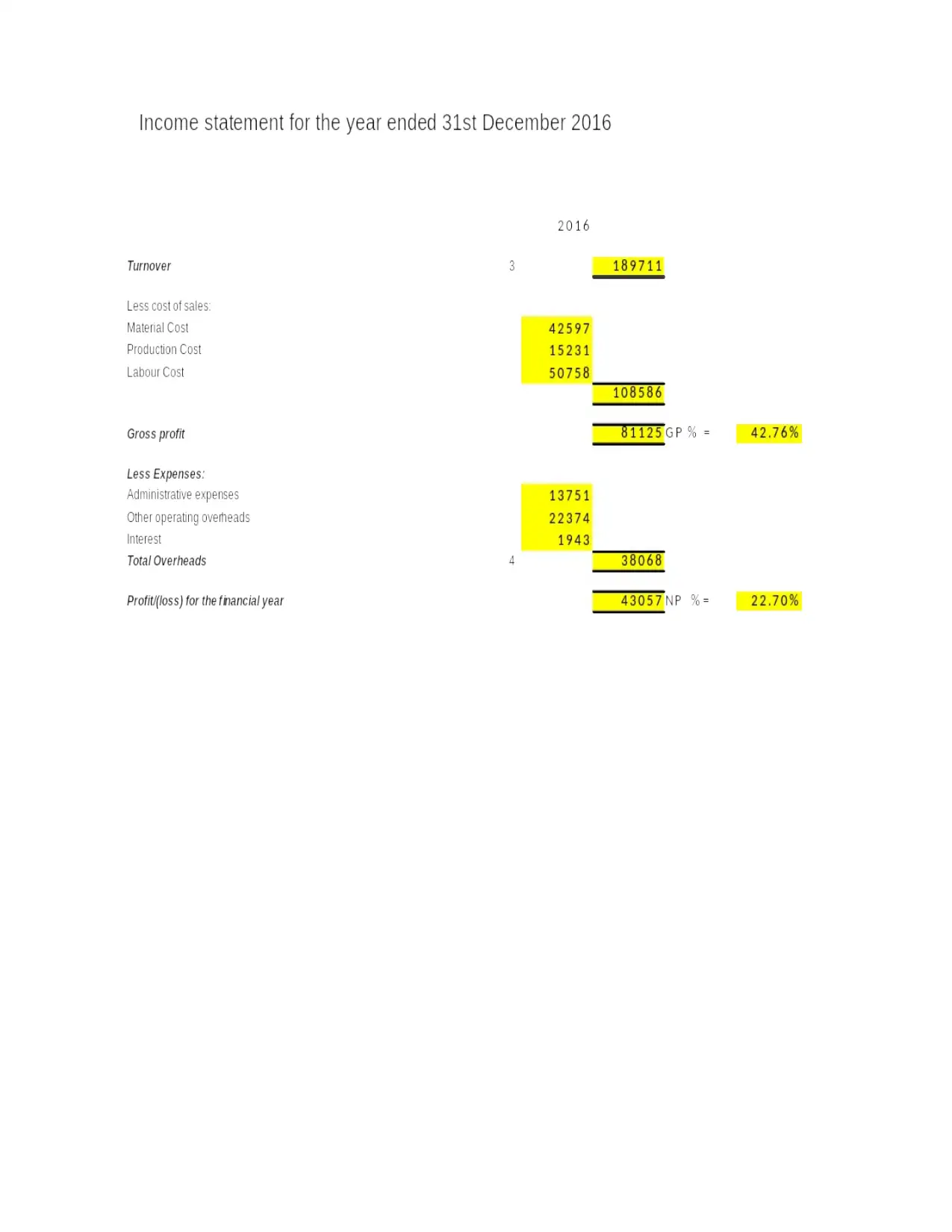
1 out of 13
Related Documents
Your All-in-One AI-Powered Toolkit for Academic Success.
+13062052269
info@desklib.com
Available 24*7 on WhatsApp / Email
![[object Object]](/_next/static/media/star-bottom.7253800d.svg)
Unlock your academic potential
© 2024 | Zucol Services PVT LTD | All rights reserved.




